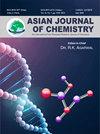基于喹啉的新型有机化学传感器的合成及其在环境样品中金属离子荧光检测中的应用,以及利用分子模型对结果进行确认:完整研究
Q4 Chemistry
引用次数: 0
摘要
通过 8-喹啉羧酸与 L-缬氨酸衍生物的缩合反应,合成了两种基于喹啉的新配体(QL1 和 QL2)。通过 1H NMR、UV、IR、HRMS 和 CHNS 等光谱技术对合成的配体进行了表征。对两种配体的三维结构进行了最低能量优化,并建立了 HOMO-LUMO 轨道。两种配体的光致发光分析表明,QL1 和 QL2 的荧光发射波长分别为 492 纳米和 508 纳米。喹啉环上的取代基影响了荧光发射波长的变化。合成的配体可作为 Cu2+ 离子的选择性荧光猝灭化学传感器,并能灵敏地检测不同水样中纳摩尔级的 Cu2+ 离子。此外,还通过建立 DFT 结构研究了金属离子与配体之间的相互作用。本文章由计算机程序翻译,如有差异,请以英文原文为准。
Synthesis of Quinoline-based New Organic Chemosensors and its Application in Fluorophoric Detection of Metal-ions in Environmental Samples and Confirmation of Results using Molecular Modelling: A Complete Study
Quinoline-based two new ligands have been synthesized (QL1 and QL2) by reacting 8-quinoline carboxylic acid with derivatives of L-valine under a condensation reaction. The synthesized ligands were characterized by spectroscopic techniques such as 1H NMR, UV, IR, HRMS and CHNS. The 3D structures of both ligands were optimized for the lowest energy and the HOMO-LUMO orbitals were developed. The photoluminescence analysis of both ligands showed the fluorescence emission wavelengths on 492 and 508 nm, respectively for QL1 and QL2. The substituents on the quinoline ring influence the change in fluorescence emission wavelengths. Synthesized ligands acted as selective fluorescence turn-off chemosensors for Cu2+ ions and demonstrated the sensitive detection of Cu2+ ions in different water samples at the nanomolar scale. The interaction between metal ion and ligands were also studied by developing DFT structures.
求助全文
通过发布文献求助,成功后即可免费获取论文全文。
去求助
来源期刊

Asian Journal of Chemistry
化学-化学综合
CiteScore
0.80
自引率
0.00%
发文量
229
审稿时长
4 months
期刊介绍:
Information not localized
 求助内容:
求助内容: 应助结果提醒方式:
应助结果提醒方式:


